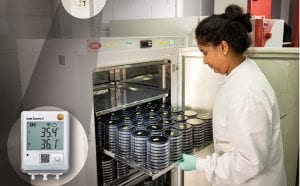Test equipment specialist Testo has supplied its latest temperature and humidity data logging system, Saveris 2, to Stansted Laboratories, facility in Barking, East London.
Stansted Laboratories is a UKAS accredited laboratory of 20 staff analysing over 50,000 samples a year in a purpose built facility. It specialises in microbiological analysis of water and air, with its main income derived from Legionella testing of water and drinking water bacteriological analysis.
Maintaining precise temperatures within its devices – incubators, fridges, freezers and water baths and cold room – is essential to ensure accuracy and for compliance with UKAS’ stringent requirements, as is maintaining a detailed record. Stansted Laboratories had been monitoring and recording equipment temperatures manually, but as the company grew this became a time consuming, labour-intensive activity.
Following a site visit, Testo recommended its Saveris 2 system, said to be a highly cost-effective, flexible temperature and humidity data logging solution specifically for small to medium sized applications, which still provides the accuracy and reliability of its larger parent system, Saveris 1.
15 Saveris 2 wireless temperature data loggers are now in use at Stansted Laboratories. The majority of the loggers are T2 which are being used to monitor temperatures in fridges, fridge freezers and incubators from -25°C to + 50°C, with T3 loggers with specialist flexible probes used for the 50°C water baths and a T1 logger with internal NTC temperature sensor in the cold room. The T2 data loggers are being used with a Testo Penetration probe NTC with ribbon cable (2 metre length) which is exceptionally flat allowing it to be pushed through narrow openings, such as the door seal of the fridges and incubators without impacting the performance of those units.
The temperature values from the data loggers are automatically recorded by the Saveris 2 system and sent directly over a wireless LAN to the Testo cloud (online storage), requiring no manual intervention.







